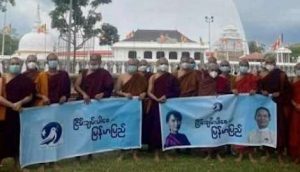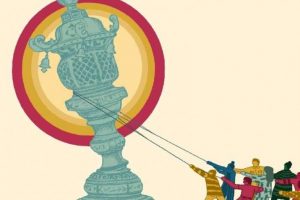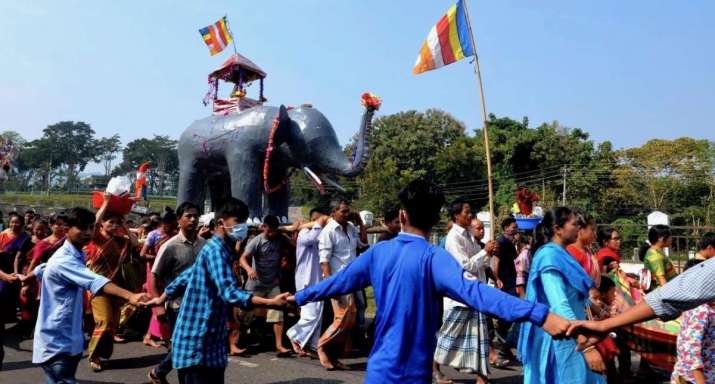
The two-day Kathin Chibar Dan (Kathina Robe Offering) ceremony, one of the biggest religious festivals for Buddhists in Bangladesh’s Chittagong Hill Tracts (CHT) was celebrated at Rajban Vihar in Rangamati District from 15–16 November. Chakma Royal Circle’s Queen Yan Yan inaugurated the festivities by operating a ceremonial spinning wheel in the presence of thousands of Buddhists from across the country.
The grounds of Rajban monastery reverberated with the sounds of chanting monks and cultural performances as the event showcased a variety of cultural forms integral to Theravada Buddhism and local Buddhists, including a procession led by an elephant image which bore the robes to be offered to the Buddhist monks.
“Every year we hold this Kathin Chibar Dan with religious fervor and festivity to preserve our tradition and customs,” said barrister Raja Devasish Roy, chief of Chakma Royal Circle. (The Daily Star)
Regarding security in the area, which has been the scene of sectarian violence in recent years, Sattyajit Barua, officer-in-charge of Rangamati police station, said more than 500 police had been deployed to prevent unwanted situations. Devasish Ray noted that the Buddhist devotes were always peaceful, sincere, and polite to people of all religions in the area.
Kathin Chibar Dan is the most important festival observed by Buddhists in Bangladesh. Throughout the day, they enjoy the ceremony along with cultural entertainments and perform numerous meritorious acts. The festival begins early in the morning: people gather at the monastery, vow to undertake the Five Precepts, and listen to Dhamma talks. The first session concludes before noon. Thereafter, the devotees serve a meal to the monks and then enjoy whatever is left over after the monks have eaten.
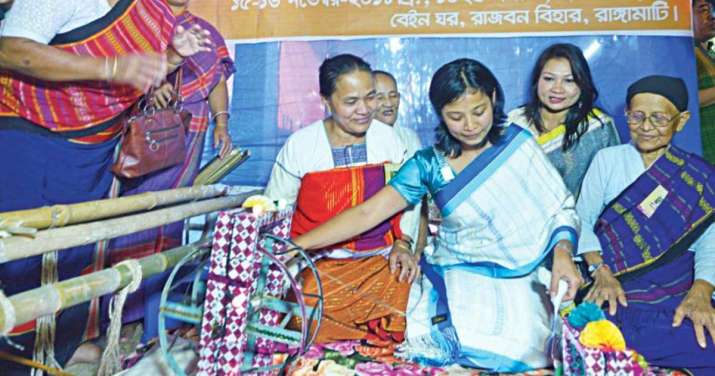
The main activities begin around 1pm, when monks give Dhamma talks and discuss the significance of the Kathina robe offerings. A representative for the laypeople leads the ceremony and announces the offering. After receiving the robes, the monks perform other activities and observe Vinaya rules. In the final session, the festival is concluded by sharing the accumulated merit with relatives and all sentient beings. In the evening, the laypeople engage in cultural programs, such as singing Buddhist songs and traditional dancing.
The historical background of the robe offering is mentioned in the Vinaya Pitaka text. While the Buddha was dwelling at Jetavana Vihar in Shravasti, a group of 30 monks visited the Buddha after their three-month rains retreat. The Buddha asked them about their retreat and noticed their worn out, threadbare robes. It is said that at the time, monks used to wear robes sewn together from pieces of cloth collected from different places such as cemeteries, discarded in the street, and rubbish heaps. To address this, the Buddha granted permission for the monks to celebrate the Kathina ceremony—with several rules, such as only those monks who have successfully completed the rains retreat may receive a Kathina robe.
Nowadays, people generally offer readymade robes to the monks, although in contrast to this practice, devotees at Rajban Vihar and some other monasteries offer handmade Kathina robes. Groups of people cooperate to prepare the fibers, cut the threads, and make the cloth. After a robe is finally sewn into its final form, the cloth is dyed a suitable color, and the finished robe is offered to the monks.
The end of the three-month rains retreat for Buddhist monks, which concluded on 24 October this year, is marked by the pavarana ceremony, which is in turn followed by Kathina robe-offering festival. This ancient custom is mostly found in the Theravada Buddhist tradition. Robes are offered until the full moon of the 12th lunar month, which this year falls on 23 November.
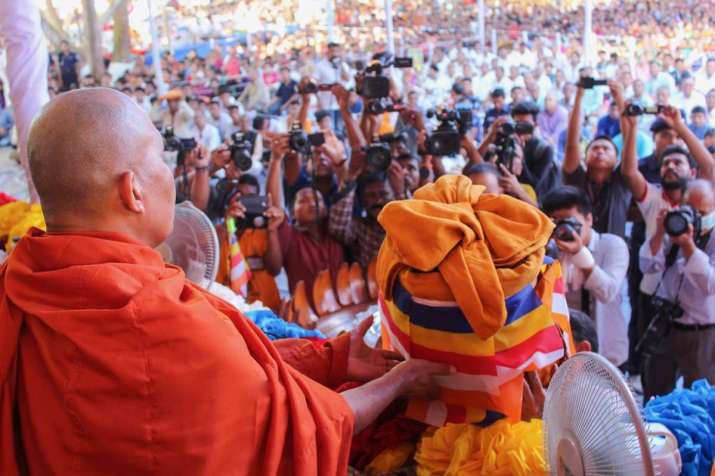
See more
Kathin Chibar Dan: Buddhists’ biggest fest begins in Rangamati (The Daily Star)
Midday Brief, Saturday, November 17, 2018 (The Daily Star)










